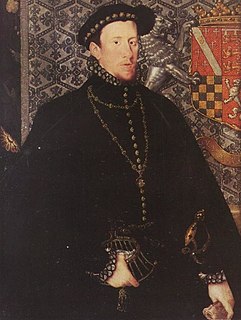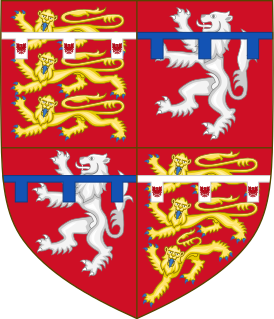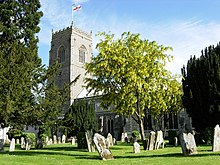
The Duke of Norfolk is the premier duke in the peerage of England, and also, as Earl of Arundel, the premier earl. The Duke of Norfolk is, moreover, the Earl Marshal and Hereditary Marshal of England. The seat of the Duke of Norfolk is Arundel Castle in Sussex, although the title refers to the county of Norfolk. The current duke is Edward Fitzalan-Howard, 18th Duke of Norfolk. The dukes have historically been Catholic, a state of affairs known as recusancy in England.

Henry Howard, Earl of Surrey, KG,, was an English nobleman, politician and poet. He was one of the founders of English Renaissance poetry and the last known execution by King Henry VIII. He was a first cousin of both Queen Anne Boleyn and Queen Catherine Howard, second and fifth wives of King Henry VIII. His name is usually associated in literature with that of Sir Thomas Wyatt, who was the older poet of the two. He was the son of Thomas Howard, Earl of Surrey and when his father became Duke of Norfolk (1524) the son adopted the courtesy title of Earl of Surrey. Owing largely to the powerful position of his father, Howard took a prominent part in the Court life of the time, and served as a soldier both in France and Scotland. He was a man of reckless temper, which involved him in many quarrels, and finally brought upon him the wrath of the ageing and embittered Henry VIII. He was arrested, tried for treason and beheaded on Tower Hill.

John Howard, 1st Duke of Norfolk, was an English nobleman, soldier, politician, and the first Howard Duke of Norfolk. He was a close friend and loyal supporter of King Richard III, with whom he was slain at the Battle of Bosworth in 1485.

Gloucester Cathedral, formally the Cathedral Church of St Peter and the Holy and Indivisible Trinity, in Gloucester, England, stands in the north of the city near the River Severn. It originated in 678 or 679 with the foundation of an abbey dedicated to Saint Peter.

Thomas Howard, 2nd Duke of Norfolk, styled Earl of Surrey from 1483 to 1485 and again from 1489 to 1514, was an English nobleman, soldier and statesman who served four monarchs. He was the eldest son of John Howard, 1st Duke of Norfolk, by his first wife, Catharina de Moleyns. The Duke was the grandfather of both Queen Anne Boleyn and Queen Catherine Howard and the great-grandfather of Queen Elizabeth I. In 1513 he led the English to victory over the Scots at the decisive Battle of Flodden, for which he was richly rewarded by King Henry VIII, then away in France.

Thomas Howard, 4th Duke of Norfolk, was an English nobleman and politician. Although from a family with strong Catholic leanings, he was raised a Protestant. He was a second cousin of Queen Elizabeth I through her maternal grandmother, and held many high offices during her reign.

Ralph Neville, 1st Earl of WestmorlandEarl Marshal, was an English nobleman of the House of Neville.
Lord William Howard was an English nobleman and antiquary, sometimes known as "Belted or Bauld (bold) Will".

Thomas de Mowbray, 4th Earl of Norfolk, 2nd Earl of Nottingham, 8th Baron Segrave, 7th Baron Mowbray, English nobleman and rebel, was the son of Thomas de Mowbray, 1st Duke of Norfolk and Lady Elizabeth FitzAlan.

Thetford Priory is a Cluniac monastic house in Thetford, Norfolk, England. It should not be confused with the Dominican Friary of Blackfriars, Thetford that later became part of Thetford Grammar School.

Anne of York was born in the Palace of Westminster, London, as the fifth daughter of King Edward IV of England and his wife, Elizabeth Woodville. She was First Lady of the Bedchamber to the queen in 1487–1494.

Sir John Wyndham, JP, of Orchard Wyndham in the parish of Watchet in Somerset, was an English landowner who played an important role in the establishment of defence organisation in the West Country against the threat of Spanish invasion.

Frances Howard,, Countess of Surrey was the daughter of John de Vere, 15th Earl of Oxford, and Elizabeth Trussell. She married firstly, Henry Howard, Earl of Surrey, son of Thomas Howard, 3rd Duke of Norfolk, and his wife Elizabeth Stafford, by whom she had two sons and three daughters:

The Priory Church of St Mary, Abergavenny is a parish church in the centre of Abergavenny in Monmouthshire, Wales.
Lady Elizabeth Stafford was an English aristocrat. She was the eldest daughter of Edward Stafford, 3rd Duke of Buckingham and Lady Eleanor Percy. By marriage she became Duchess of Norfolk. Her abusive marriage to Thomas Howard, 3rd Duke of Norfolk, created a public scandal.

St Paul's is a Church of England church in the Georgian St Paul's Square in the Jewellery Quarter, Birmingham, England.
Sir William Bagot was a politician and administrator under Richard II.

Sir John Wyndham of Orchard Wyndham in the parish of Watchet, Somerset, was born a member of a prominent gentry family in Norfolk and founded his own prominent gentry family in Somerset, which survives today at Orchard Wyndham.

St Michael's Church at Chenies, Buckinghamshire, is a Grade I listed Anglican parish church in the Diocese of Oxford in England. It is not of great architectural interest but stands in an attractive position in the Chess Valley near the Chenies Manor House. The church is famous for its Bedford Chapel, the mausoleum of the Russell family which is private and not open to the public.
Robert Howard (1385—1436), Knight, of Stoke by Nayland, Suffolk, was an English nobleman, the eldest son of John Howard (c.1366-1437), of Wiggenhall and East Winch, Norfolk, by the latter's second wife, Alice Tendring. Alice was also an heiress, although not to the same degree as John Howard's first wife, Lady Plaiz, who had brought him estates worth over £400 per annum. They had two sons; Robert was the elder. His younger brother, Henry Howard, was to be later murdered by retainers of John, Baron Scrope of Masham, after his parents and brother had died.




















